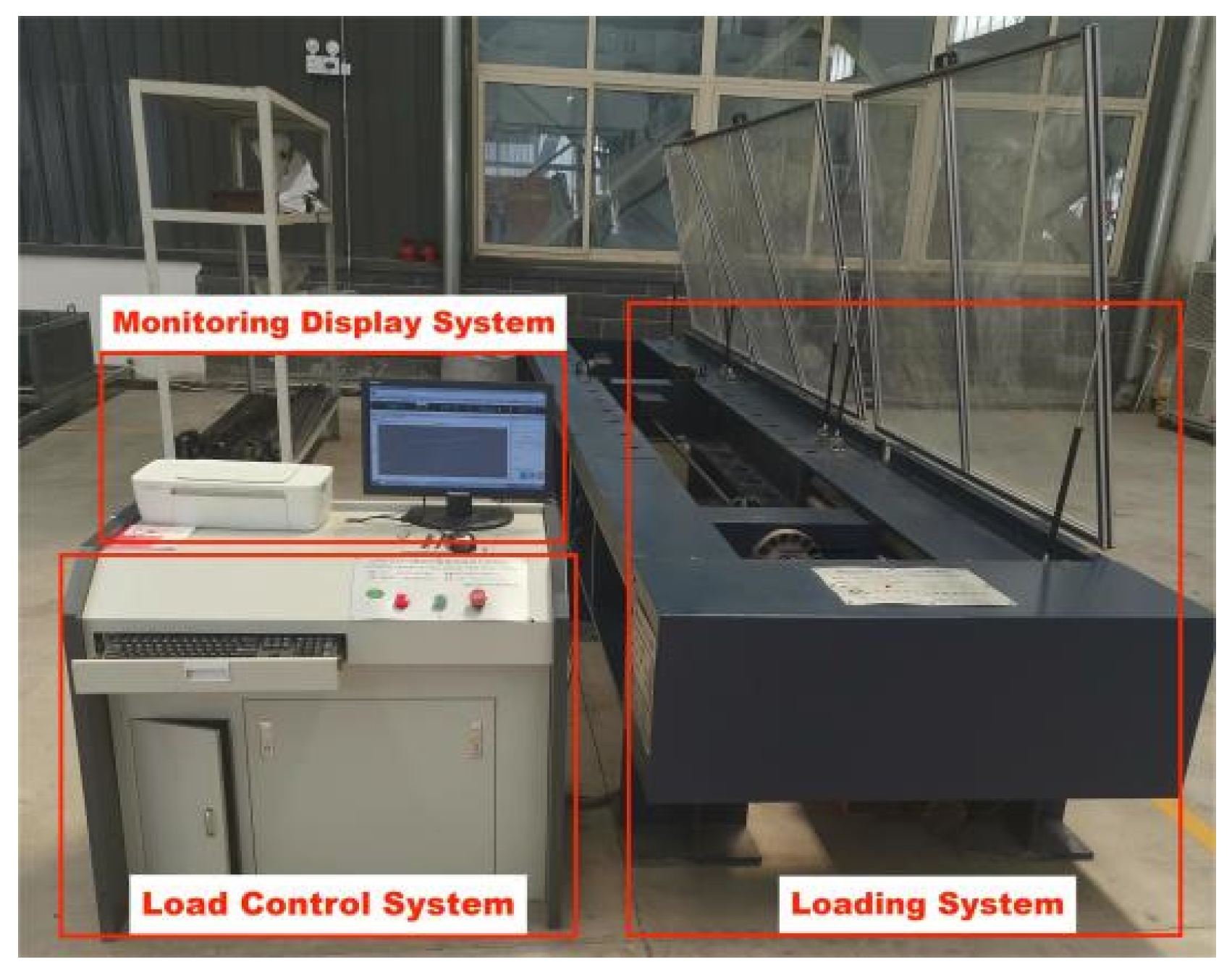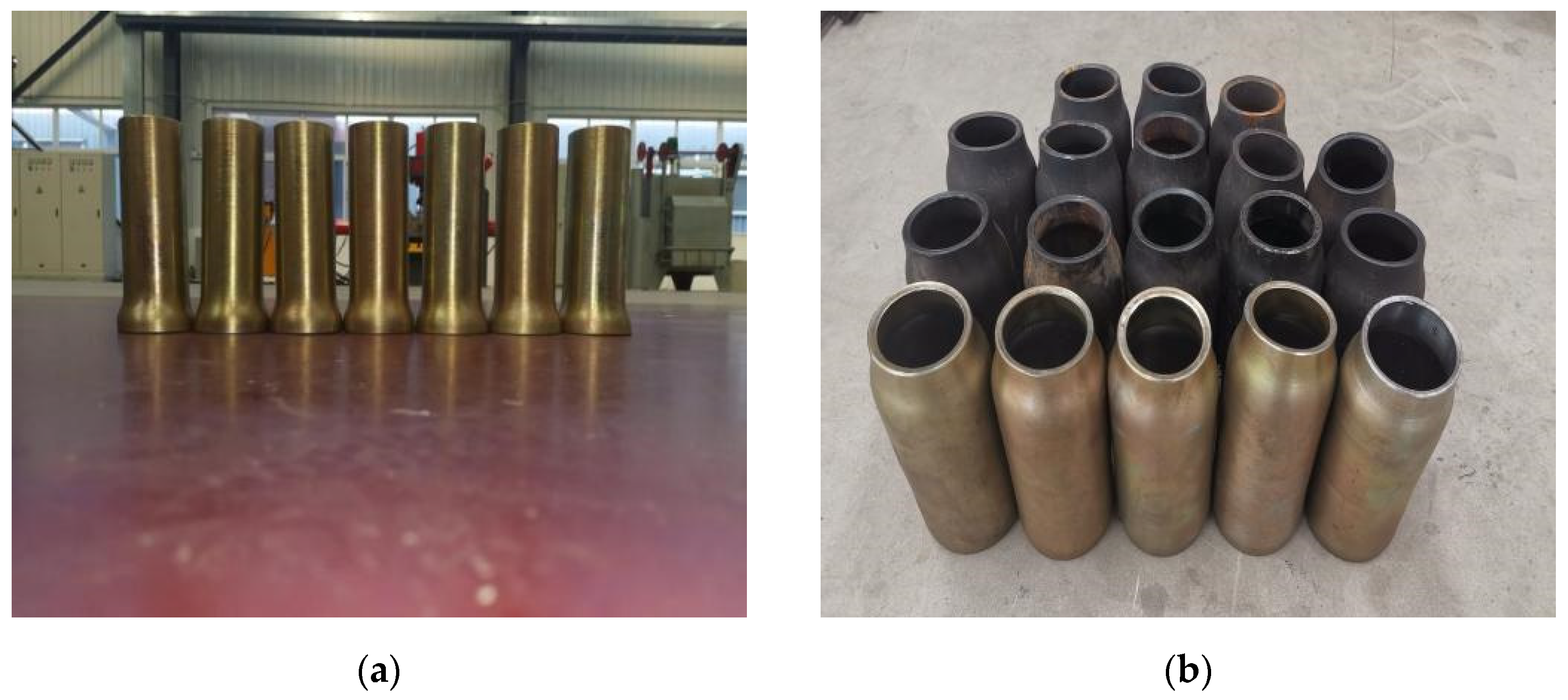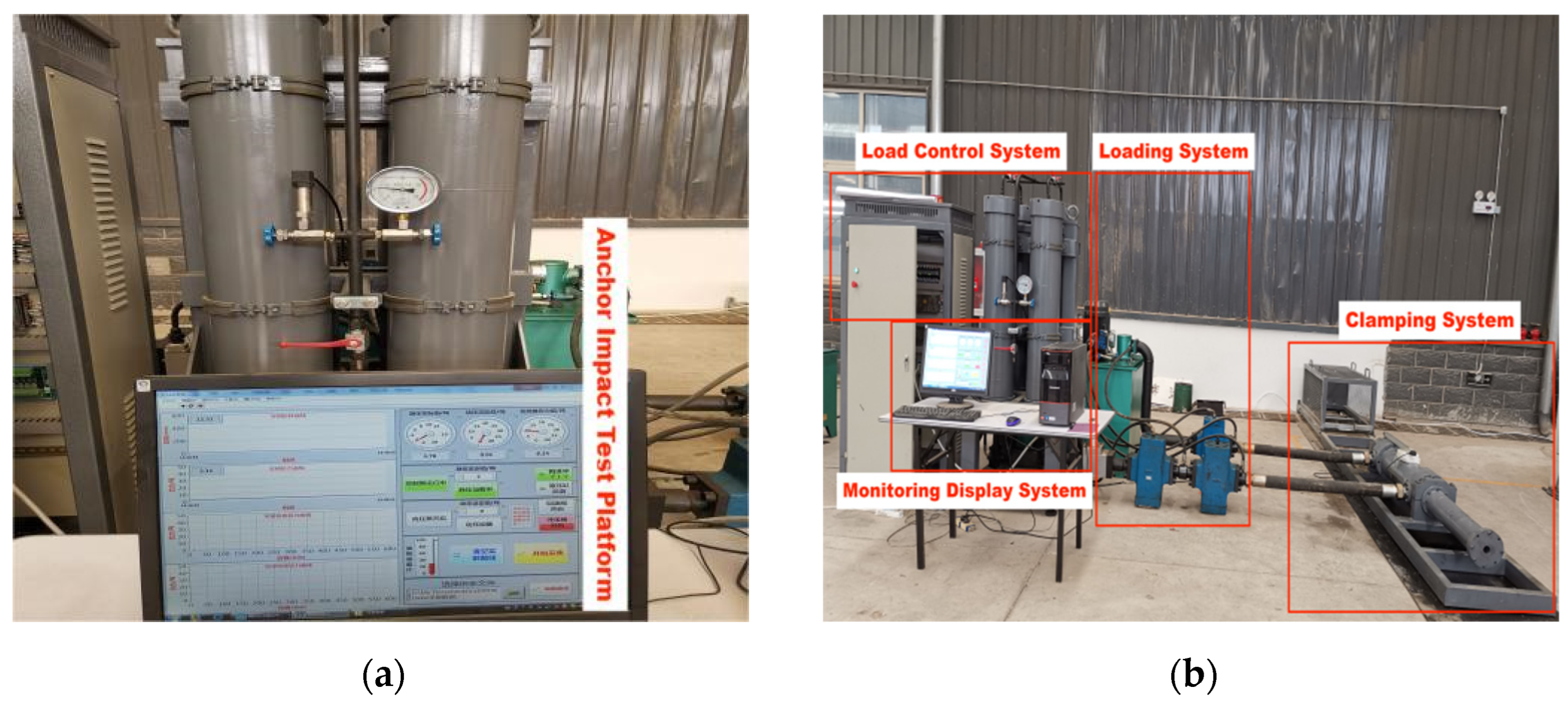Experimental Study on Mechanical Properties of Automatic Anchoring Preloaded Energy Absorbing Anchor Rods
Abstract
:1. Introduction
2. Energy Absorbing Anchor Design
2.1. Energy Absorbing Anchor Structure
2.2. Functional Characteristics of Energy Absorbing Anchor
2.2.1. Automatic Determination of Anchorage Force
2.2.2. Automatic Determination of Preload Force
2.2.3. Early Warning Function and Logo
2.3. Anti-Impact Mechanism of Energy Absorbing Anchor and Applicability Analysis
3. Analysis of Mechanical Properties of Anchor under Static Load
3.1. Basic Parameters of Specimen
3.1.1. Basic Parameters of Conventional Anchor Specimen
3.1.2. Basic Parameters of Energy Absorbing Anchor Specimen
3.2. Study on Static Load Test of Conventional Anchor
3.3. Study on Static Load Test of Energy Absorbing Anchor Anchor
4. Analysis of Mechanical Properties of Anchor under Impact Load
4.1. Study on Impact Load Test of Conventional Anchor
4.2. Study on Impact Load Test of Energy Absorbing Anchor
4.3. Comparison of Mechanical Properties of Conventional Anchor and Energy Absorbing Anchor in Impact Load Tests
5. Conclusions
Author Contributions
Funding
Data Availability Statement
Acknowledgments
Conflicts of Interest
References
- Aldrian, W.; Wyink, U.; Herrmann, C. Bolting with pumpable reactive resins—More than fixation of steel dowels in rock. Geomech. Tunn. 2019, 12, 168–174. [Google Scholar] [CrossRef]
- Pan, Y.S.; Xiao, Y.H.; Li, G.Z. Research and application of anti–scour hydraulic support in roadway. J. China Coal Soc. 2020, 45, 90–99. [Google Scholar] [CrossRef]
- Pan, Y.S.; Qi, Q.X.; Wang, A.W. Three–level support theory and technology of coal mine rock burst roadway. J. China Coal Soc. 2020, 45, 1585–1594. [Google Scholar] [CrossRef]
- Skrzypkowski, K. Case Studies of Rock Bolt Support Loads and Rock Mass Monitoring for the Room and Pillar Method in the Legnica–Głogów Copper District in Poland. Energies 2020, 13, 2998. [Google Scholar] [CrossRef]
- Małkowski, P.; Niedbalski, Z.; Majcherczyk, T. Underground monitoring as the best way of roadways support design validation in a long time period. Min. Miner. Depos. 2020, 14, 1–14. [Google Scholar] [CrossRef]
- Matayev, A.; Abdiev, A.; Kydrashov, A. Research into technology of fastening the mine workings in the conditions of unstable masses. Min. Miner. Depos. 2021, 15, 78–86. [Google Scholar] [CrossRef]
- Skrzypkowski, K. An Experimental Investigation into the Stress–Strain Characteristic under Static and Quasi–Static Loading for Partially Embedded Rock Bolts. Energies 2021, 14, 1483. [Google Scholar] [CrossRef]
- Greig, K.; John, H. Influence of Testing Configuration on the Performance of Paddled Energy–Absorbing Rockbolts Under Impact Loading. Rock Mech. Rock Eng. 2022, 55, 5705–5721. [Google Scholar] [CrossRef]
- Kang, H.P.; Lin, J.; Wu, Y.Z. Mechanical performances and compatibility of rock bolt components. J. China Coal Soc. 2015, 40, 11–23. [Google Scholar] [CrossRef]
- Wu, Y.Z.; Fu, Y.K.; Zheng, J.W. Dynamic mechanical properties and strain rate effect of bolts. J. China Coal Soc. 2020, 45, 3709–3716. [Google Scholar] [CrossRef]
- Dong, S.Y.; Chu, X.W. Design and Analysis of Energy Absorption and Rock Burst Prevention Support Component for Mine Bolt. Coal Mine Mach. 2020, 41, 62–64. [Google Scholar] [CrossRef]
- Ning, Y.G.; Ma, S.W.; Cao, C. Analysis of bolting failure in deep mining roadway and support countermeasures. Coal Sci. Technol. 2021, 49, 23–29. [Google Scholar] [CrossRef]
- He, M.C.; Guo, Z.B. Mechanical property and engineering application of anchor bolt with constant resistance and large deformation bolt. Chin. J. Rock Mech. Eng. 2014, 33, 1297–1308. [Google Scholar] [CrossRef]
- Wang, Q.; He, M.C.; Xu, S. Mechanical properties and engineering application of constant resistance energy absorbing bolt. J. China Coal Soc. 2022, 47, 1490–1500. [Google Scholar] [CrossRef]
- Fu, Y.K.; Ju, W.J.; Wu, Y.Z. Mechanism and practice of energy absorption and anti–impact of bolt (cable) in deep mining roadway. J. China Coal Soc. 2020, 45, 609–617. [Google Scholar] [CrossRef]
- Wang, A.W.; Fan, D.W.; Pan, Y.S. Expansion–friction energy absorption anti–impact cable and its mechanical characteristic. J. China Coal Soc. 2022, 47, 695–710. [Google Scholar] [CrossRef]
- Wang, A.W.; Pan, Y.S.; Zhao, B.Y. Static and dynamic mechanical properties of energy absorption bolts (cable) and field tests. Chin. J. Geotech. Eng. 2017, 39, 1292–1301. [Google Scholar]
- Wang, A.W.; Fan, D.W.; Pan, Y.S. Determination of three–level energy absorbing support parameters in rock burst roadway based on energy calculation. Coal Sci. Technol. 2021, 49, 72–81. [Google Scholar] [CrossRef]
- Wang, A.W.; Pan, Y.S.; Qi, Q.X. Strength calculation method of three–level energy absorption support in rockburst roadways for coal mines. J. China Coal Soc. 2020, 45, 3087–3095. [Google Scholar] [CrossRef]
- Wang, A.W.; Pan, Y.S.; Zhao, B.Y. Coupling vibration characteristics of rock mass and energy–absorption bolt and its anti–impact mechanism. J. China Coal Soc. 2016, 41, 2734–2742. [Google Scholar] [CrossRef]
- Tang, Z.; Wu, H.; Liu, Y. Numerical Analysis of Mechanical Characteristics of Constant–Resistance, Energy–Absorbing and Anti–Scour Bolts. Materials 2022, 15, 3464. [Google Scholar] [CrossRef] [PubMed]












| Anchor Length /m | Anchor Diameter /mm | Anchor Tray Wall Thickness /mm | Material Model | Yield Strength /MPa | Ensile Strength /MPa | Density /g·cm−3 | Modulus of Elasticity /GPa | Poisson’s Ratio |
|---|---|---|---|---|---|---|---|---|
| 2 | 22 | 8 | Q235 | 235 | 380 | 7.85 | 207 | 0.27 |
| Anchor Length /m | Anchor Diameter /mm | Anchor Tray Wall Thickness /mm | Length of Constant Resistance Absorber /mm | Inner Wall Diameter /mm | Wall Thickness /mm | Cone Angle of Conical Surface /(°) | Height of Cylindrical Structure /mm |
|---|---|---|---|---|---|---|---|
| 2 | 22 | 8 | 150 | 41 | 3 | 53.6° | 15 |
| Diameter of cylindrical structure/mm | Material Model | Yield strength /MPa | Ensile strength /MPa | Density /g·cm−3 | Modulus of elasticity /GPa | Poisson’s ratio | |
| 50 | Q235 | 235 | 380 | 7.85 | 207 | 0.27 | |
| Anchor Form | Yield Distance/mm | Absorbed Energy/kJ | Damaged Load/kN |
|---|---|---|---|
| conventional anchor | 197.17 | 31.99 | 192.14 |
| energy absorbing anchor | 329.58 | 51.62 | 193.40 |
| Loading Method | Yield Distance/mm | Absorbed Energy/kJ | Damaged Load/kN |
|---|---|---|---|
| static load | 197.17 | 31.99 | 192.14 |
| impact load | 165.96 | 31.08 | 203.49 |
| Loading Method | Yield Distance/mm | Absorbed Energy/kJ | Damaged Load/kN |
|---|---|---|---|
| static load | 329.58 | 51.62 | 193.40 |
| impact load | 335.37 | 57.63 | 203.31 |
| Anchor Form | Yield Distance /mm | Absorbed Energy /kJ | Impact Resistance Time/s | Damaged Load/kN |
|---|---|---|---|---|
| conventional anchor | 165.96 | 31.08 | 0.15 | 203.49 |
| energy absorbing anchor | 335.37 | 57.63 | 0.22 | 203.31 |
Disclaimer/Publisher’s Note: The statements, opinions and data contained in all publications are solely those of the individual author(s) and contributor(s) and not of MDPI and/or the editor(s). MDPI and/or the editor(s) disclaim responsibility for any injury to people or property resulting from any ideas, methods, instructions or products referred to in the content. |
© 2023 by the authors. Licensee MDPI, Basel, Switzerland. This article is an open access article distributed under the terms and conditions of the Creative Commons Attribution (CC BY) license (https://creativecommons.org/licenses/by/4.0/).
Share and Cite
Tang, Z.; Zuo, W.; Cai, X.; Chang, D.; Wu, C. Experimental Study on Mechanical Properties of Automatic Anchoring Preloaded Energy Absorbing Anchor Rods. Processes 2023, 11, 1130. https://doi.org/10.3390/pr11041130
Tang Z, Zuo W, Cai X, Chang D, Wu C. Experimental Study on Mechanical Properties of Automatic Anchoring Preloaded Energy Absorbing Anchor Rods. Processes. 2023; 11(4):1130. https://doi.org/10.3390/pr11041130
Chicago/Turabian StyleTang, Zhi, Wenbo Zuo, Xiaoqiao Cai, Dezhi Chang, and Chunye Wu. 2023. "Experimental Study on Mechanical Properties of Automatic Anchoring Preloaded Energy Absorbing Anchor Rods" Processes 11, no. 4: 1130. https://doi.org/10.3390/pr11041130
APA StyleTang, Z., Zuo, W., Cai, X., Chang, D., & Wu, C. (2023). Experimental Study on Mechanical Properties of Automatic Anchoring Preloaded Energy Absorbing Anchor Rods. Processes, 11(4), 1130. https://doi.org/10.3390/pr11041130








